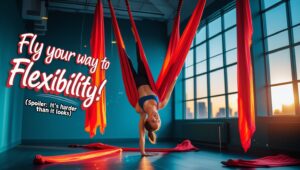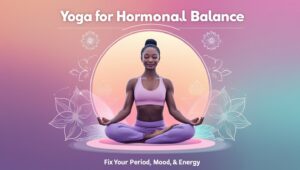
Aerial yoga, a blend of traditional poses and modern fitness techniques, has become a go-to practice for those seeking back pain relief, improved flexibility, and a fun way to stay fit. This innovative form of yoga combines traditional poses, Pilates, and dance with the use of a suspended hammock. Beyond its visually stunning appeal, aerial yoga offers a multitude of health benefits that cater to both the mind and body. From relieving back pain to aiding weight loss, aerial yoga seamlessly blends traditional yoga with modern fitness techniques, offering a unique and versatile practice that caters to a variety of health goals. In this article, we delve into the science-backed advantages of aerial yoga, how it works, and why it might just be the fitness routine you’ve been searching for.
What Is Aerial Yoga?
Aerial yoga involves performing various poses and exercises while supported by a silk hammock that hangs from the ceiling. The hammock acts as a prop to assist, deepen, or challenge traditional yoga postures. For example, the supported “Inverted Butterfly” pose allows practitioners to comfortably stretch their spine and open their hips while suspended, making the pose more accessible and relaxing. This unique approach allows practitioners to explore movements in a three-dimensional space, defy gravity, and achieve a sense of weightlessness.
Top Benefits of Aerial Yoga
1. Back Pain Relief
One of the most celebrated benefits of aerial yoga is its potential to alleviate back pain. The hammock provides gentle support that helps decompress the spine, reducing pressure on vertebral discs. Inversions, where the body hangs upside down, promote spinal traction, enhance flexibility, and improve posture. This can be particularly beneficial for individuals with chronic back pain or those who spend long hours sitting at a desk.
2. Enhanced Flexibility and Mobility 🧘
The suspended hammock allows for deeper stretches that might be difficult to achieve on the ground. Over time, aerial yoga can improve overall flexibility and joint mobility, helping practitioners achieve a wider range of motion. This benefit extends beyond the mat, enhancing physical performance in daily activities and other forms of exercise.
3. Core Strength and Stability 💪
Balancing and transitioning between poses in the air requires significant core engagement. Aerial yoga strengthens the abdominal muscles and improves overall stability. This increased core strength not only benefits your practice but also contributes to better posture and reduced risk of injury.
4. Weight Loss and Muscle Toning 🏋️♂️
Aerial yoga is a full-body workout that combines strength training, cardio, and stretching. The dynamic movements help burn calories while toning muscles. Over time, regular practice can contribute to weight loss and improved body composition.
5. Stress Reduction and Mental Clarity 🌸
Like traditional yoga, aerial yoga incorporates mindfulness, breathing techniques, and meditation. The sensation of floating in the air can be deeply calming, reducing stress and anxiety. Additionally, inversions stimulate blood flow to the brain, enhancing mental clarity and focus.
6. Improved Balance and Coordination ⚖️
Suspension work challenges your sense of balance, enhancing coordination and proprioception (the awareness of your body’s position in space). These skills are crucial for overall physical health and can prevent falls, especially as we age.
7. Joint Decompression and Pain Relief 🩺
Unlike high-impact exercises, aerial yoga is gentle on the joints. The hammock supports your body weight, reducing stress on joints while allowing for effective strength and flexibility training.
Getting Started with Aerial Yoga
What You Need 🛠️
To begin your aerial yoga journey, you’ll need access to a yoga hammock, sturdy anchors, and a safe space with sufficient height. Most studios provide all necessary equipment, making it easy for beginners to dive in.
Beginner Tips 🏆
Take a Class: Enroll in a beginner’s aerial yoga class to learn the basics under professional guidance.
Wear Comfortable Clothing: Opt for fitted, stretchy clothing to avoid fabric snags.
Be Patient: It may take time to build confidence and master the poses. Start slow and listen to your body.
Safety Precautions ⚠️
Ensure the hammock is securely fastened and can support your weight.
Avoid practicing inversions if you have certain medical conditions, such as glaucoma or high blood pressure.
Always practice on a padded surface to reduce the risk of injury.
Who Can Benefit from Aerial Yoga?
Aerial yoga is suitable for a wide range of individuals, from fitness enthusiasts to those looking for a gentle, therapeutic exercise. It’s particularly beneficial for:
🧑🦰 People with back pain or poor posture
📊 Those seeking a low-impact workout
🎨 Yoga practitioners looking to deepen their practice
💪 Individuals aiming to improve strength, flexibility, and balance
Science Behind the Benefits
Numerous studies support the benefits of aerial yoga. For instance, a 2016 study by the American Council on Exercise (ACE) found that aerial yoga can improve balance, core strength, and flexibility while also burning up to 320 calories per hour. Research shows that regular practice can:
🌟 Reduce cortisol levels, lowering stress
❤️ Enhance cardiovascular health through moderate aerobic activity
💜 Improve spinal health by reducing compression and increasing mobility
🎤 Boost mood and mental well-being
Common Misconceptions About Aerial Yoga
1. It’s Only for the Flexible 🤸♂️
Aerial yoga is accessible to people of all flexibility levels. The hammock provides support, making poses achievable even for beginners.
2. It’s Too Difficult for Beginners 🤔
While some poses may look advanced, aerial yoga is highly adaptable. Instructors often modify poses by adjusting the hammock height, offering simpler variations, or using additional props to suit different skill levels. For example, beginners might start with a lower hammock height to build confidence before progressing to more challenging poses.
3. It’s Unsafe ❌
When practiced correctly under proper guidance, aerial yoga is safe. Quality equipment and trained instructors minimize risks.
FAQs About Aerial Yoga
Q: Can beginners try aerial yoga?
Q: Is aerial yoga safe for people with back pain?
Q: What should I wear to an aerial yoga class?
Q: Can aerial yoga help with weight loss?
Q: Are there any health conditions that make aerial yoga unsafe?
Final Thoughts
Aerial yoga is more than just a trend; it’s a transformative practice that offers a unique blend of physical and mental benefits. Whether you’re looking to alleviate back pain, improve flexibility, or simply try something new, aerial yoga has something for everyone. So, why not take the leap and discover the joys of flying yoga?















Add comment